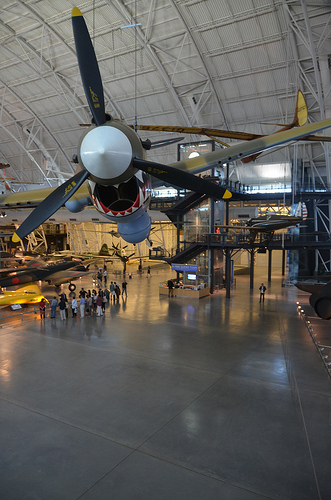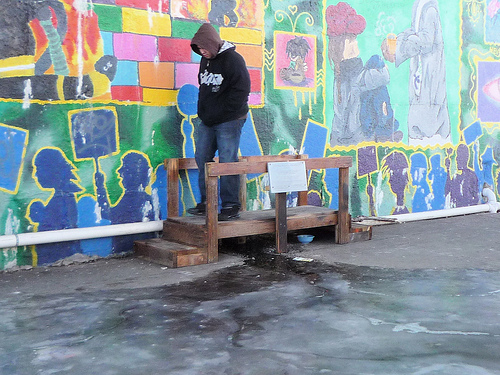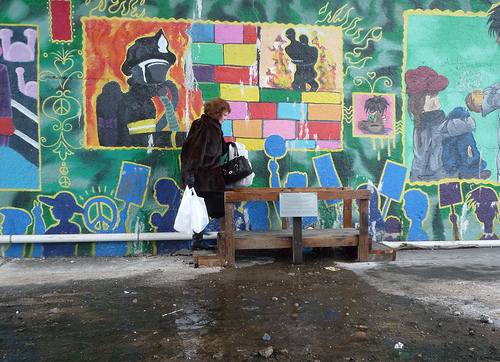A handful of nice speedy prototype expense photos I found:
Steven F. Udvar-Hazy Center: major hall panorama (P-40 et al)

Image by Chris Devers
See far more pictures of this, and the Wikipedia post.
Specifics, quoting from Smithsonian National Air and Space Museum | Curtiss P-40E Warhawk (Kittyhawk IA):
Regardless of whether recognized as the Warhawk, Tomahawk, or Kittyhawk, the Curtiss P-40 proved to be a productive, versatile fighter for the duration of the 1st half of Globe War II. The shark-mouthed Tomahawks that Gen. Claire Chennault’s "Flying Tigers" flew in China against the Japanese remain among the most well-known airplanes of the war. P-40E pilot Lt. Boyd D. Wagner became the initial American ace of Globe War II when he shot down six Japanese aircraft in the Philippines in mid-December 1941.
Curtiss-Wright constructed this airplane as Model 87-A3 and delivered it to Canada as a Kittyhawk I in 1941. It served until 1946 in No. 111 Squadron, Royal Canadian Air Force. U.S. Air Force personnel at Andrews Air Force Base restored it in 1975 to represent an aircraft of the 75th Fighter Squadron, 23rd Fighter Group, 14th Air Force.
Donated by the Exchange Club in Memory of Kellis Forbes.
Manufacturer:
Curtiss Aircraft Firm
Date:
1939
Country of Origin:
United States of America
Dimensions:
Overall: 330 x 970cm, 2686kg, 1140cm (10ft 9 15/16in. x 31ft 9 7/8in., 5921.6lb., 37ft four 13/16in.)
Supplies:
All-metal, semi-monocoque
Physical Description:
Single engine, single seat, fighter aircraft.
Long Description:
Whether it was the Tomahawk, Warhawk, or Kittyhawk, the Curtiss P-40 was a successful and versatile fighter aircraft for the duration of the very first half of World War II. The shark-mouthed Tomahawks that General Claire Chennault led against the Japanese stay among the most common airplanes of the war. In the Phillipines, Lt. Boyd D. Wagner became the initial American ace of Globe War II whilst flying a P-40E when he shot down six Japanese aircraft in the course of mid-December 1941. P-40s had been very first-line Army Air Corps fighters at the start off of the war but they quickly gave way to a lot more advanced designs such as the Republic P-47 Thunderbolt and the Lockheed P-38 Lightning (see NASM collection for each aircraft). The P-40 is not ranked amongst the very best overall fighters of the war but it was a rugged, successful style obtainable in huge numbers early in the war when America and her allies urgently necessary them. The P-40 remained in production from 1939 to the finish of 1944 and a total of 13, 737 had been constructed.
Design and style engineer Dr. Donovan R. Berlin layed the foundation for the P-40 in 1935 when he designed the agile, but lightly-armed, P-36 fighter equipped with a radial, air-cooled engine. The Curtiss-Wright Corporation won a production contract for 210 P-36 airplanes in 1937-the biggest Army airplane contract awarded since World War I. Worldwide, fighter aircraft styles matured rapidly throughout the late 1930s and it was quickly apparent that the P-36 was no match for newer European styles. Higher altitude efficiency in particular became a priceless commodity. Berlin attempted to boost the P-36 by redesigning it in to accommodate a turbo-supercharged Allison V-1710-11 inline, liquid-cooled engine. The new aircraft was designated the XP-37 but proved unpopular with pilots. The turbo-supercharger was not trustworthy and Berlin had placed the cockpit too far back on the fuselage, restricting the view to the front of the fighter. Nonetheless, when the engine was not providing difficulty, the more-streamlined XP-37 was considerably faster than the P-36.
Curtiss attempted again in 1938. Berlin had modified yet another P-36 with a new Allison V-1710-19 engine. It was designated the XP-40 and initial flew on October 14, 1938. The XP-40 looked promising and Curtiss provided it to Army Air Corps leaders who evaluated the airplane at Wright Field, Ohio, in 1939, along with several other fighter proposals. The P-40 won the competitors, soon after some modifications, and Curtiss received an order for 540. At this time, the armament package consisted of two .50 caliber machine guns in the fuselage and 4 .30 caliber machine guns in the wings.
Right after production started in March 1940, France ordered 140 P-40s but the British took delivery of these airplanes when Paris surrendered. The British named the aircraft Tomahawks but located they performed poorly in higher-altitude combat over northern Europe and relegated them to low-altitude operations in North Africa. The Russians purchased far more than two,000 P-40s but information of their operational history stay obscure.
When the United States declared war, P-40s equipped numerous of the Army Air Corps’s front line fighter units. The plucky fighter at some point saw combat in nearly every theater of operations becoming the most powerful in the China-Burma-India (CBI) Theater. Of all the CBI groups that gained the most notoriety of the whole war, and remains to this day synonymous with the P-40, is the American Volunteer Group (AVG) or the Flying Tigers. The unit was organized right after the Chinese gave former U. S. Army Air Corps Captain Claire Lee Chennault nearly 9 million dollars in 1940 to get aircraft and recruit pilots to fly against the Japanese. Chennault’s most critical help within the Chinese government came from Madam Chiang Kai-shek, a Lt. Colonel in the Chinese Air Force and for a time, the service’s general commander.
The funds from China diverted an order placed by the British Royal Air Force for one hundred Curtiss-Wright P-40B Tomahawks but getting airplanes was only 1 essential step in making a fighting air unit. Educated pilots had been necessary, and quickly, as tensions across the Pacific escalated. On April 15, 1941, President Franklin D. Roosevelt quietly signed an Executive Order permitting Chennault to recruit straight from the ranks of American military reserve pilots. Inside a couple of months, 350 flyers joined from pursuit (fighter), bomber, and patrol squadrons. In all, about half the pilots in the Flying Tigers came from the U. S. Navy and Marine Corps although the Army Air Corps supplied a single-third. Factory test pilots at Bell, Consolidated, and other firms, and commercial airline pilots, filled the remaining slots.
The Flying Tigers flew their very first mission on December 20. The unit’s name was derived from the ferocious fangs and teeth painted on the nose of AVG P-40s at either side of the distinctive, large radiator air intake. The idea is mentioned to originate from photographs in a magazine that showed Royal Air Force Tomahawks of No. 112 Squadron, operating in the western desert of North Africa, adorned with fangs and teeth painted around their air intakes. The Flying Tigers have been the first true opposition the Japanese military encountered. In less than 7 months of action, AVG pilots destroyed about 115 Japanese aircraft and lost only 11 planes in air-to-air combat. The AVG disbanded on July 4, 1942, and its assets, like a handful of pilots, became a part of the U. S. Army Air Forces (AAF) 23rd Fighter Group in the newly activated 14th Air Force. Chennault, now a Brigadier General, assumed command of the 14th AF and by war’s finish, the 23rd was one particular of the highest-scoring Army fighter groups.
As wartime experience in the P-40 mounted, Curtiss made many modifications. Engineers added armor plate, far better self-sealing fuel tanks, and a lot more powerful engines. They modified the cockpit to improve visibility and changed the armament package to six, wing-mounted, .50 caliber machine guns. The P-40E Kittyhawk was the first model with this gun package and it entered service in time to serve in the AVG. The final model produced in quantity was the P-40N, the lightest P-40 built in quantity, and considerably more quickly than prior models. Curtiss built a single P-40Q. It was the fastest P-40 to fly (679 kph/422 mph) but it could not match the overall performance of the P-47 Thunderbolt and the P-51 Mustang so Curtiss ended development of the P-40 series with this model. In addition to the AAF, a lot of Allied nations purchased and flew P-40s which includes England, France, China, Russia, Australia, New Zealand, Canada, South Africa, and Turkey.
The Smithsonian P-40E did not serve in the U. S. military. Curtiss-Wright constructed it in Buffalo, New York, as Model 87-A3 and delivered it to Canada as a Kittyhawk IA on March 11, 1941. It served in No. 111 Squadron, Royal Canadian Air Force (RCAF). When the Japanese navy moved to attack Midway, they sent a diversionary battle group to menace the Aleutian Islands. Canada moved No. 111 Squadron to Alaska to assist defend the region. Soon after the Japanese threat diminished, the unit returned to Canada and sooner or later transferred to England without its P-40s. The RCAF declared the NASM Kittyhawk IA surplus on July 27, 1946, and the aircraft sooner or later returned to the United States. It had a number of owners just before ending up with the Explorer Scouts youth group in Meridian, Mississippi. For the duration of the early 1960s, the Smithsonian began browsing for a P-40 with a documented history of service in the AVG but discovered none. In 1964, the Exchange Club in Meridian donated the Kittyhawk IA to the National Aeronautical Collection, in memory of Mr. Kellis Forbes, a neighborhood man devoted to Boys Club activities. A U. S. Air Force Reserve crew airlifted the fighter to Andrews Air Force Base, Maryland, on March 13, 1964. Andrews personnel restored the airplane in 1975 and painted it to represent an aircraft of the 75th Fighter Squadron, 23rd Fighter Group, 14th Air Force.
• • •
Quoting from Wikipedia | Curtiss P-40 Warhawk:
The Curtiss P-40 Warhawk was an American single-engine, single-seat, all-metal fighter and ground attack aircraft that 1st flew in 1938. It was utilized by the air forces of 28 nations, including these of most Allied powers in the course of Planet War II, and remained in front line service until the end of the war. It was the third most-created American fighter, soon after the P-51 and P-47 by November 1944, when production of the P-40 ceased, 13,738 had been constructed, all at Curtiss-Wright Corporation‘s principal production facility at Buffalo, New York.
The P-40 style was a modification of the previous Curtiss P-36 this lowered improvement time and enabled a rapid entry into production and operational service.
Warhawk was the name the United States Army Air Corps adopted for all models, making it the official name in the United States for all P-40s. The British Commonwealth and Soviet air forces employed the name Tomahawk for models equivalent to the P-40B and P-40C, and the name Kittyhawk for models equivalent to the P-40D and all later variants.
The P-40’s lack of a two-stage supercharger made it inferior to Luftwaffe fighters such as the Messerschmitt Bf 109 or the Focke-Wulf Fw 190 in high-altitude combat and it was rarely employed in operations in Northwest Europe. Amongst 1941 and 1944, nonetheless, the P-40 played a crucial role with Allied air forces in 3 main theaters: North Africa, the Southwest Pacific and China. It also had a significant role in the Middle East, Southeast Asia, Eastern Europe, Alaska and Italy. The P-40’s overall performance at higher altitudes was not as critical in these theaters, where it served as an air superiority fighter, bomber escort and fighter bomber.
P-40s first saw combat with the British Commonwealth squadrons of the Desert Air Force (DAF) in the Middle East and North African campaigns, during June 1941. The Royal Air Force‘s No. 112 Squadron was among the 1st to operate Tomahawks, in North Africa, and the unit was the first to function the "shark mouth" logo, copying similar markings on some Luftwaffe Messerschmitt Bf 110 twin-engine fighters. [N 1]
Though it gained a post-war reputation as a mediocre design, appropriate only for close air assistance, much more current analysis including scrutiny of the records of person Allied squadrons indicates that the P-40 performed surprisingly well as an air superiority fighter, at occasions suffering severe losses, but also taking a very heavy toll on enemy aircraft. The P-40 supplied the further benefit of low cost, which kept it in production as a ground-attack fighter extended right after it was obsolete in the air superiority part.
As of 2008, 19 P-40s were airworthy.
Astoria Scum River Bridge

Image by jasoneppink
For much more than twenty years, a leaky pipe on 33rd Street beneath the Hell Gate Bridge viaduct approach submerged a lot more than a hundred square feet of heavily-trafficked sidewalk under a festering cesspool of standing water. Astoria Scum River, as it was known as, stretched the whole width of the sidewalk, and as winter approached, the river iced over and became particularly hazardous to cross.
Astoria Scum River Bridge was constructed to provide Astorians an opportunity to safely cross this hazard. The unauthorized bridge was a present to the pedestrians of Astoria in the absence of effective municipal efforts to ameliorate the problem.
The bridge was made at zero price completely from recycled supplies: an old work bench discovered on the curb, rescued screws from a disassembled desk, and a metal plate from an expired electrical element. It was installed and devoted on December 30th, 2009.
On January 25th, 2010, Astoria Scum River Bridge was the subject of a commendation from the workplace of NYC Council Member Peter F. Vallone, Jr., accompanied by a pledge to work with Amtrak to re-route Astoria Scum River off the sidewalk.
Two days later, Amtrak workers began construction operate. Astoria Scum River was speedily routed off the sidewalk, and inside a couple months, custom-made grates have been installed to comprehensive the project. The bridge, no longer required, was de-installed on March 20th, 2010 and returned to the curb whence it came.
Astoria Scum River Bridge is an unauthorized city improvement by Jason Eppink and Posterchild.
Astoria Scum River Bridge

Image by jasoneppink
For more than twenty years, a leaky pipe on 33rd Street beneath the Hell Gate Bridge viaduct approach submerged much more than a hundred square feet of heavily-trafficked sidewalk under a festering cesspool of standing water. Astoria Scum River, as it was called, stretched the complete width of the sidewalk, and as winter approached, the river iced over and became specifically hazardous to cross.
Astoria Scum River Bridge was constructed to offer Astorians an opportunity to safely cross this hazard. The unauthorized bridge was a gift to the pedestrians of Astoria in the absence of successful municipal efforts to ameliorate the difficulty.
The bridge was created at zero expense completely from recycled materials: an old operate bench identified on the curb, rescued screws from a disassembled desk, and a metal plate from an expired electrical element. It was installed and dedicated on December 30th, 2009.
On January 25th, 2010, Astoria Scum River Bridge was the topic of a commendation from the office of NYC Council Member Peter F. Vallone, Jr., accompanied by a pledge to operate with Amtrak to re-route Astoria Scum River off the sidewalk.
Two days later, Amtrak workers began construction perform. Astoria Scum River was swiftly routed off the sidewalk, and inside a couple months, custom-produced grates had been installed to complete the project. The bridge, no longer required, was de-installed on March 20th, 2010 and returned to the curb whence it came.
Astoria Scum River Bridge is an unauthorized city improvement by Jason Eppink and Posterchild.